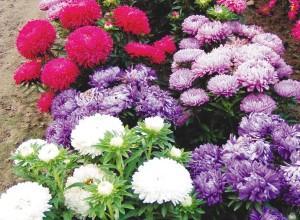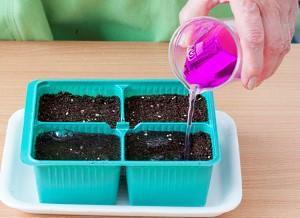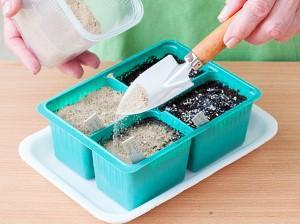Seedlings of asters - all the subtleties of the process
 Multi-colored asters bloom for a long time in the fall, decorating the flower garden. This plant is not whimsical, so there are no difficulties in growing. Aster can be sown with seeds directly into the ground or planted her seedlingsthen flowering will come earlier. Growing aster seedlings at home requires certain knowledge about caring for young seedlings. If agricultural technology is not followed, young plants can get sick and die, which often happens among inexperienced growers. Let's consider in detail the whole process of growing aster seedlings on the windowsill of the house: from sowing seeds to planting on the street.
Multi-colored asters bloom for a long time in the fall, decorating the flower garden. This plant is not whimsical, so there are no difficulties in growing. Aster can be sown with seeds directly into the ground or planted her seedlingsthen flowering will come earlier. Growing aster seedlings at home requires certain knowledge about caring for young seedlings. If agricultural technology is not followed, young plants can get sick and die, which often happens among inexperienced growers. Let's consider in detail the whole process of growing aster seedlings on the windowsill of the house: from sowing seeds to planting on the street.
When to sow asters for seedlings?
It is necessary to sow aster seeds in a timely manner, since overgrown seedlings take root worse, and later sowing of seeds does not make sense. Good, healthy aster seedlings can be obtained from fresh, last year's seeds, which are sown from late March to the second decade of April. Later sowing is already carried out directly into the ground at a permanent place of growth.
Growing seedlings of asters from seeds
For sowing work, we need:
- Drawers at least 5 cm high;
- A piece of glass, the dimensions of which correspond to the box;
- Soil from earth, humus and sand in equal proportions;
- Wood ash;
- Perlite;
- A weak solution of potassium permanganate;
- Pack with aster seeds.

 A plastic or wooden seedling box is filled with prepared soil, slightly compacted and spilled abundantly with potassium permanganate.
A plastic or wooden seedling box is filled with prepared soil, slightly compacted and spilled abundantly with potassium permanganate.
Seeds must be treated with any fungicide before planting. This is the most effective remedy against fungal diseases that often affect aster seedlings on the windowsill of the house.
Shallow furrows (up to 2 cm) are made in the ground and aster seeds are laid out. Then they are sprinkled with soil on top, but no more than 2 mm. The distance between the grooves should be 2-5 cm.
Experienced flower growers advise sprinkling aster seeds with calcined sand 0.5 cm thick, which will avoid blocking during watering and the development of the "black leg" disease.
Crops are covered with a piece of glass to prevent rapid evaporation of moisture.
Seedlings asters appear on the 5-10th day, after which the glass is removed from the box. The seedlings are moved to a windowsill with good lighting, but the temperature should not be higher than 15 ° C. This is an important condition when growing aster seedlings at home, otherwise it will stretch out.
As it dries, the soil is moistened with warm water from a spray bottle. It is important not to overdo it and not flood the plants, otherwise the black leg may hit the seedlings. As soon as the first signs of this disease are found, diseased shoots are immediately removed with a small clod of earth. The hole is covered with earth and this place is spilled with a fungicide solution.
Aster seedlings picking
 This procedure must be carried out when 2-3 true leaves appear on the aster seedlings.The composition of the soil during transplantation should not differ, but an additional spoonful of complex mineral fertilizer is added to the finished soil. For an even distribution of fertilizer, the soil is thoroughly mixed.
This procedure must be carried out when 2-3 true leaves appear on the aster seedlings.The composition of the soil during transplantation should not differ, but an additional spoonful of complex mineral fertilizer is added to the finished soil. For an even distribution of fertilizer, the soil is thoroughly mixed.
Pots or cassettes fill with soil and compact it slightly so that the soil does not settle down much after watering. A recess is made with a stick in the center of the pot, in which the roots of the seedling will freely fit. A plant with a highly branched root system is pinched. When transplanting, the seedling is buried in the soil, but no more than 1 cm from the cotyledon leaves.
 The soil around the sprout is compacted so that it does not wash out with water when watering.
The soil around the sprout is compacted so that it does not wash out with water when watering.
Each pot is carefully spilled with warm water, and watered from the edge of the pot, gradually moving towards the center. It is important to ensure that no water gets on the plant leaves. The cut aster seedlings are exposed in a bright place, preventing direct sunlight. The optimum temperature for asters is + 20 ° C.
The subsequent care of aster seedlings is not difficult. As the soil in the pot dries up, the seedlings are watered with warm water; there is no need to feed it if the soil was originally filled with mineral fertilizers.
Additional mineral fertilization of plants will be required if planting is delayed due to cold weather. When 4-5 leaves are formed on aster plants, the seedlings need to be gradually hardened in the fresh air, for which the pots are taken out into the street in a slightly darkened place.
Personally, I always sow asters directly into the ground in the second part of May or at the end of the month, in the loosened, fertilized soil, water it with water, warming it to room temperature, cover it with agrofilm and wait for the first gatherings. And almost every year, in late August or early September, my favorites amuse me, sometimes until the end of October, if there is no frost.